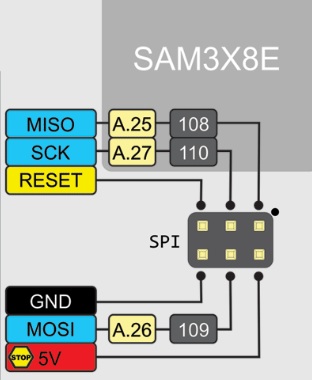

You would define them in the declarations area of your sketch like this… Looking at the datasheets, the RH805 is a MSB first device that likes SPI Mode 2, while the RH764 is an LSB first device that likes SPI Modes 0 and 3. For example, let’s say you had two chips: the Rheingold RH805 Framistat, and the Rheingold RH764 Combobulator. This can be used to define a SPI device interaction in your Arduino code, and is the system that allows you to change the way you interact with devices on the fly, by having preset definitions for speed, bit order and SPI Mode using the configuration values above. SPISettings mySPISettings(speed, dataOrder, dataMode) Latch on the initial clock edge, sample on the subsequent edge. Sample on the initial clock edge, latch on the subsequent edge.

These values correspond directly to the SPI Modes covered in the SPI Signaling module. The bit order value sets the direction in which data is sent to the SPI slave devices, and the order in which the system will expect data to be returned. The system should be smart enough to slow the clock down to a speed compatible with your hardware, so even if you’re running a slower clock, it should slow down the SPI CLK frequency accordingly. If you have a 16 MHz UNO, then these values are applicable. The allowed speeds are 32bit ratios of the clock speed of your Arduino. The speed value set the frequency of the clock signal on the SPI bus. First we’ll cover the various configuration values. The old commands are included below for reference. These functions are now condensed into the SPISettings and begin/end transaction commands.
#SPI ARDUINO SERIES#
Originally, there were a series of functions that were necessary in order to configure the bus each time you accessed a differently configured chip. Each of the functions below were executed followed with a five second delay that allowed me to capture what the scope was displaying at each stage. The oscilloscope traces below were generated by setting the scope to trigger on a single negative going edge on the SDA signal bus, which would indicate the beginning of the Start Condition. I’ve listed them below in the order that you’re likely to use them.
#SPI ARDUINO CODE#
These are made available in your code by using the command #include “SPI.h” at the top of your sketch. There are ten functions created by the SPI library, that you use to allow your Arduino to interact with SPI devices on the bus. There are several files in that path, including the example code that is available to you in the IDE, but the heart of SPI communications with an Arduino resides in two files… Arduino/hardware/arduino/avr/libraries/SPI directory on the machine you write your code on. The SPI Library is a series of files in plain text that exist in the.


Additionally, if you wish to replicate the oscilloscope traces, use a four channel oscilloscope capable of reading a 4Mhz signal connected to the SCK, MISO, MOSI and Chip Select lines between an Arduino and any SPI chip, and then send each function listed below as necessary with sufficient delay time in between to allow you to view the resulting scope trace. Be very careful when opening those files though, that you don’t modify them or you’ll need to reinstall everything from scratch. No setup is required, however you can access the files that comprise the SPI library in the program folders installed with your Arduino IDE. No schematic is associated with this module. Know which functions actually cause data to transmit and which are only preparatory.Learn the 10 SPI Library functions and their purpose.Determine which commands are used to configure the SPI interactions.Now that we have a firm understanding of how we need to configure the signals to communicate with a SPI component, let’s look at the Arduino SPI Library that will actually manage all of that signaling for us.


 0 kommentar(er)
0 kommentar(er)
